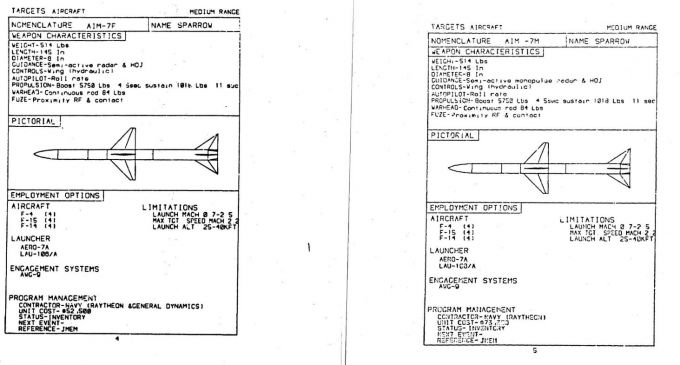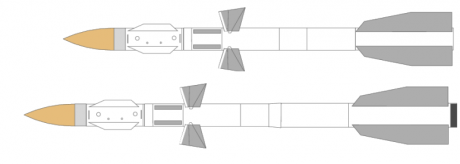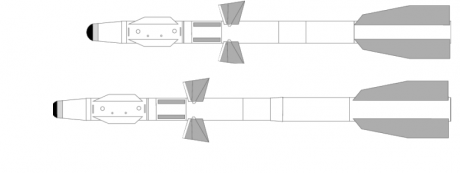FC3
Contents
DCS FC3 A/A introductory Guide
Introduction
FC3 is the third in a series of reduced complexity, but not reduced realism, modules. This package of aircraf is ment to be a cheap entry way into the DCS world environment. Now don't confuse this lack of clickable and fully modeled systems as a meaning the FM is lacking. The F15's FM in particular is one of the most accurate in the game rivaling the F14's FM. Additionally the Russian aircraft's FM's were made with assistance from the Russian government and each has had a substantial amount of tuning put into it. This makes these aircraft very realistic to fly while still being easy enough to just pick up and fly even for a novice.
NATO Weapons
AIM-7
The Sparrow III is the third major revision of the venerable sparrow design of the early 1950's. It was the frontline BVR A/A missile for the United States Airforce, Marine Core, and Navy until the early to mid 1990's; ultimately being replaced by the AIM-120 series of missiles. The sparrow III, when compared to its predecessors, is a significant improvement in every way, it features a design that was easily upgradable over time. The ultimate version we have in DCS the MH variant features lofting logic and improved CCM performance over previous models.
F
The first Sparrow variant fielded of the new type the F sets the aerodynamics and range for all futures sparrows. Unique to this variant is the ability to home in on either a CW signal or a PD signal. Even though not implemented on the F14 yet, in the future you should be able to choose between the two modes. This in game means all three types of sparrow perform kinematically the same, however the F's chaff resistance is extremely low and can be decoyed with only a few chaff bundles.
M
The upgrade to the F-model, the M build irl received a new, and substantially better, monopulse seeker and a choice between two nose cones. One optimized for radar performance the other for aerodynamic performance. The monopulse seeker gives this missiles an inherent resistance to chaff and ECM. However this means it can only home in on a PD signall. In game the only difference from the F is a substantially improved chaff resistance.
MH
The MH variant is the most modern sparrow currently in DCS. This variant uses parts from the AIM-7P to improve its long range performance with lofting and low altitude performance with newer guidance computers. Additionally, the CCM logic was upgraded substantially. In game this makes the MH the most effective variant due to its lofting and CCM performance making chaff have a very low effectiveness against it.
AIM-120
The AIM-120 is the premier BVR missile of the Western world, it has seen use in the middle east and Balkans. Proving itself to be the most capable operationally used missile of all time. Over the course of its life it has received numerous upgrades that have all increased its lethality. The AIM-120 achieves this lethality in no small part due to the fact it is an active missile that has been made exceptionally small yet still has a very powerful motor. Being an active missile it has its own radar to hunt down targets allowing the firing aircraft to retreat the moment it launches. The latest variants of the 120 the D model have even added the ability to fire the missile on datalinked targets and at HOBS targets.
B
The B model AMRAAM was the second iteration of the AIM-120 series with an improved guidance section being the only upgrade over the A model. Externally and internally the two are essentially the same missile. As such the B offers a missile with good range, good maneuverability, and the immense advantage of a fire and forget missile.
C-5
The C-5 is an early 2000's variant of the AMRAAM. It differs from the B in that the fins of the missile were redesigned so they could fit into the weapon bays of the F-22 Raptor. This also has the side effect of offering reduced drag for slight loss in lift. In addition to this over the course of the C's development from C to C-3 to C-4. It has received new warheads, guidance sections, and an every increasingly more powerful and longer burning motor.
AIM-9
The Sidewinder is the longest serving missile series in the world. It has seen massive improvements over the more than 50 years it has been in service. The F16 can currently carry three types the AIM-9L, AIM-9M, and the AIM-9X
L
The '9L' was the first of the "unified" Sidewinder models, as previously the Airforce and Navy had their own unique model, this one was the first to be used by both branches. The L was a major upgrade over all previous sidewinders, heavily based on the AIM-9H the ultimate navy only variant. The L featured a new cooled InSb (Indium Antimonide) FM spin seeker which provides some natural resistance to IR counter measures, a completely new electronics package, increased off boresight capabilities, higher max G, higher launch g (7g's), much longer flight time of 1 minute, New warhead, new and more powerful motor.
M
The '9M' in shape, size, weight, and even appearance is the same missile. But on the inside its electronics got completely overhauled. These new electronics could now filter out flares based on a flares energy rise time. And be reprogrammed to keep it up to date with the latest threats.
In addition these updates almost completely eliminated the effect of background noise on target detection range. In addition to this the 9M got a new smokeless motor that almost completely removed the smoke signature of the missile.
PACT Weapons
AA-8B (R-60M)
The R-60M is a very short range, medium to high maneuverability IR missile. An upgrade to the R-60 (AA-8A) this model provides a significantly improved seeker allowing for all aspect engagements. Having a rudimentary autopilot and a AM seeker the missile both has very poor off boresight range (pulls to hard off the rail and kills its speed) and no ability to filter out IR countermeasures.
- Even though improved seeker lock on range is still poor. Especially in the frontal aspect.
- Off boresight range of 17°'s, which was exceptional for the early 70's but was quickly surpassed.
- 3.5Kg warhead - very rarely will one hit kill an aircraft, often two hits is required.
- Kinematic rage is very very very poor (very high drag missile) achieving a max aero-range of only 10km above an altitude of 16km. Range at sea level for a head on target, from a high subsonic launch is no more than 2km.
- Very smoky missile easily seen even at long ranges
- Very poor CCM resistance
- Moderate maneuverability, for the time this missile came out it was superior or equivalent to most western counterparts.
AA-10A/C (R27R/ER)
The AA-10 (R-27) Alamo series of missiles was a common series of modern SARH/IR missiles meant to equip the Russian fighters of the 1970's. Although due to numerous delays and cost overruns the missile was deployed late. By the time it was deployed an upgraded version of the R-23 the R-24 and the new series of Sparrow missiles where already outperforming the missile. However despite this the missile was kept in service and steadily improved over time. The A/C variants are the SARH version of the R-27 series. The A model is the original missile design. It has a monopulse seeker that homes in on a CWI signal. In addition to this the missile has a rudimentary datalink to allow launches beyond the range the seeker could normally detect a target. Allowing the missile to have extended ranges, it is unknown if this was done to compensate in some way for the seeker having limited detection capabilities or to allow use on a less powerful radar. Additionally, even though not modeled in DCS, it has been stated by some sources the 27's seeker had a lot of trouble with background noise from terrain and when within 3km of terrain the S/N (Trackable target signal to background noise) ratio was so poor the missile could no longer track a target. The ER model was the next in the R-27 series, it provided a much larger Boost-Sustain type motor greatly extending the range of the missile.
- A Model has very very very poor range (will be changed at some point)
- Limited AP capabilities missile if fired off boresight will bleed a lot of energy, it is recommended to only fire when directly looking at the target (according to Chizh, and ED dev, this is accurate to the rlf missile)
- ER has moderate range and outranges most missiles
- Very smoky missile easily seen even at long ranges
- Very poor CCM resistance
- Has HOJ capabilities
- Large warhead a hit is almost always a guaranteed kill
AA-10B/D (R27T/ET)
The AA-10 (R-27) Alamo series of missiles was a common series of modern SARH/IR missiles meant to equip the Russian fighters of the 1970's. Although due to numerous delays and cost overruns the missile was deployed late. By the time it was deployed an upgraded version of the R-23 the R-24 and the new series of Sparrow missiles where already outperforming the missile. However despite this the missile was kept in service and steadily improved over time. The B/D variants are the IR version of the R-27 series. The T model is based on the original missile, has an IR sensor with full aspect targeting capabilities however due to sever limitations in both background noise filtering and has no ability to filter out flares. Both its detection and tracking range are not impressive in the front aspect but it provided SUBSTANTIALLY more range in tail chase engagements than the R60M. The R-27ET is essentially the same missile as the R-27T but with a substantially enlarged Boost-Sustain motor.
- Moderate range especially for tail chase engagements with the ET
- Very smoky missile easily seen even at long ranges
- Very poor CCM resistance
- Poor detection and tracking ranges on aircraft not in AB especially head on
- Large warhead a hit is almost always a guaranteed kill
AA-11 (R73E)
The R-73 Archer was a world class short range IR missile from its deployment in the mid 80's until the mid 90's . To increase upon the maneuverability achieved with the R-60 both a similar design was chosen and a thrust vectoring system was added, the first of its kind in the world. Additionally unlike other Russian missile of the time the missiles autopilot was quite advanced with programs to limit the intensity of the maneuvering when coming off the rail to just what was needed to hit, to maximize off boresight range when compared to all other Russian missiles.
- Incredible maneuverability only surpassed by the AIM-9X and other modern western equivalents.
- Substantially more range than the R-60M achieving a sea level RMax ~9 times greater (~17-18km)
- Off boresight launch range range of 45°'s.
- Super smoky rocket motor, very easy to see even at long range
- Moderately sized warhead roughly a 50/50 chance if 1 hit will result in a kill
- Very poor CCM resistance, has no mechanisms to filter out flares
Note at some point it is likely the more modern R-73M will be added, the main difference is a larger motor increasing range and time the missile can thrust vector. But most importantly the introduction of a Dual-Band seeker that would substantially improve flare resistance against older countermeasure systems.
AA-12 (R77)
The R-77 Adder is a medium ranged active homing missile. Developed in the 1980's it is currently the most advanced Russian missile in the game. A completely new design the R77 is a very unique looking missile, the 4 gridfins on the back give this missile some unique traits. First it is one of the few missile designs to have a lower (value that is part of the drag equation) than at subsonic speeds. Meaning this missile, for its class, has very low supersonic drag and very high supersonic lift. It will not decelerate in this region as quickly as one would expect or turn as poorly. However when slowing down towards the trans-sonic region the missile looses speed very rapidly till it goes subsonic where the drag falls off again.
- Very smoky missile easily seen even at long ranges.
- Poor range when compared to its contemporaries, has a bit more range than the AA-10A (R-27R).
- More advanced autopilot reducing energy loss to maneuvering.
- Poor to moderate CCM resistance.
- Has HOJ capabilities.
- High maneuverability when subsonic (M0 to .8) and at high supersonic (M3+), moderate maneuverability for remaining Mach numbers.
- Large warhead, a hit is almost always a guaranteed kill.
- Carried only on the J-11A and the MIG-29S
Controls
It is recommended to bind as many of these to your HOTAS as you can with keys such as target lock, weapon release, and countermeasures taking priority.
General
- Navigation mode (1)
- BVR mode (2)
- Vertical scan ACM mode (3)
- Boresight Mode (4)
- Flaps Toggle (F)
- Cannon select (C)
- Flare Dispense (Delete)
- Chaff Dispense (Insert)
- Jammer (E)
- Trim (RCtrl + arrow keys) - very important for Russian planes
- External Fuel tanks eject all (LAlt + R) - F15C only
- Gun Trigger (RAlt + Space)
- Weapon release (Space)
- Target Lock (Enter)
- Return to search (BackSpace)
- Unlock TWS target - F15 only
- Change weapons (D)
- Radar on (I)
- TWS mode (RAlt + I)
- Change PRF (RShift + I)
- Radar range scale Up/Down ()
Russian specific
- Takeoff thrust (LShift + E) - For SU-33 only, used when taking off from the kunetsov when near max takeoff weight. Provides the extra thrust needed for this but can damage the engines if left on too long.
- Auto-Thrust (J) - SU-33 only
- Level hold autopilot (H) - autopilot will level the jet and fly on the heading you were when it was activated
- Route Following Autopilot (A) - Autopilot will follow the direct route set up in the ME
EO scanner on (O) - Predicted target range up/down (RCtrl + =/-)
- HMD mode (5)
- ASC direct control(S) - "cobra switch"
Radar Displays
F-15C
- - symbol is for hostile aircraft
- O symbol is for allied aircraf
Su-27/MIG-29/Su-33/J-11A
On Russian aircraft starting from the MIG-23 the radar information was displayed on the HUD instead of a separate screen. This philosophy differed from the US one but the way it was displayed was almost identical. As a top down view of what the radar sees. With an emphasis on visual cues to help guide the pilots eyes to where the scanning patter is using the horizon and HUD as a reference.
- PRF
- "ППС" - Hi PRF, offers great long range detection at the cost of detection range of flanking or retreating targets
- "ЗПС" - Medium PRF, offeres good short to medium range detection and substantially better detection of flanking or retreating targets.
- "ABT" - interleaved, alternates between Hi and Medium PRF to gain the advantages of both with only an average 25% reduction in max detection range.
- Radar Modes
- "ОБЗ" - BVR RWS/IRST Mode
- "СНП" - BVR TWS Mode
- "АТК ДВБ" - BVR STT
- "ВС БВБ" - Vertical Scan ACM Mode
- "ОПТ БВБ" - Boresight Scan ACM Mode
- On the right side there is a vertical bar, this represents the radar's position. The elevation coverage of the radar bar is calculated from the expected range number set and seen on the bottom of the HUD.
- The middle bar on the left of the main vertical line represents the location of the horizon.
- The two bars on the outside represent the viewing angle of the HUD. In the above case we see that the HUD's center is slightly above the horizon.
- To the right of this the small vertical bar with a number is the scan pattern looking for a target that is expected to be Xkm above or below your aircraft. This number is representative of this Xkm value. In addition to this you need to set the expected range number to make this tool accurate.
- On the HUD the different sized targets is actually due to the radar measuring the approximate RCS of a detected target. The measured RCS is represented by the number of dots seen denoting a target. The more the dots the larger the target.
- One dot indicates an RCS of 2m^2 or less (stealth aircraft or small trainers)
- Two dots indicates an RCS of 2-30m^2, this is the range of just about every fighter, attacker, and multirole aircraft
- Three dots is 30-60m^2 and is usually medium bombers or small tankers
- Four dots is 60m^2 or larger and these are almost exclusively very large tankers or AWACS aircraft.
PACT Datalink
An advantage the SU-27 and SU-33 have over the rest of the FC3 aircraft is access to a tactical datalink:
- ^ shapes indicate either hostile or unknown contacts. If the triangle has a base then your radar sees that target.
- O shapes indicate known friendly aircraft on the network.
- The length of the _ on top of each symbol indicates how much higher or lower than you they are
- The length of the direction line indicates airspeed









